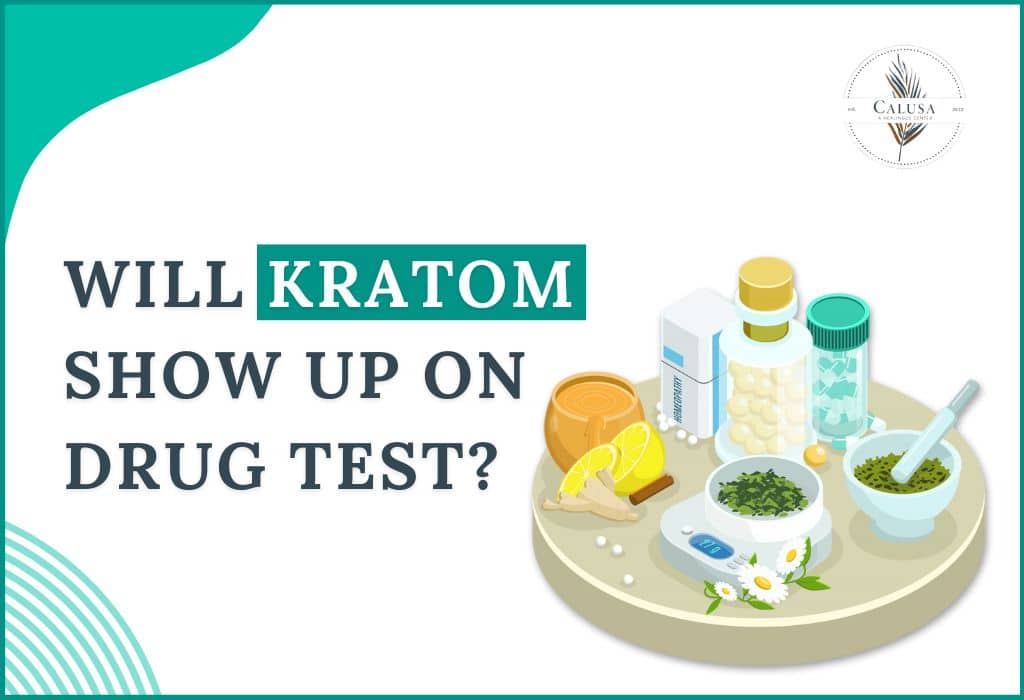Kratom has become notably popular as a natural remedy for various illnesses such as pain, anxiety, and symptoms of opioid withdrawal. Originating from the Southeast Asian region, Kratom is made from the leaves of the Mitragyna speciosa tree and is famous for its unique psychoactive properties. As more people discover the therapeutic effects of Kratom, concerns about its presence in drug tests are becoming increasingly frequent. Its unique psychoactive properties offer potential therapeutic benefits, but with increased use comes a common question: will kratom show up on a drug test?
It is essential to know how Kratom affects drug tests, especially among individuals who may be subject to regular testing for legal, medical, or employment purposes. This differs from other known substances where detection of Kratom in drug tests is not always straightforward with many misconceptions.
Understanding Kratom
Kratom also known scientifically as Mitragyna speciosa is a tropical tree that grows indigenously in Southeast Asia specifically in countries like Thailand, Indonesia, Malaysia, and Papua New Guinea. For centuries now, the leaves of the Kratom have been used traditionally by healers to manage pain boost energy levels, and improve one’s mood when feeling downcast or even bored. The leaves can be consumed as whole leaves or they could be ground into powder capsules or extracts amongst other forms. Today, kratom comes in various forms, from whole leaves to powdered capsules and extracts. But with its growing popularity, a new question arises: will kratom show up on a drug test?
Common Uses and Benefits
- Chronic Pain Relief: A Natural Alternative to Opioids.
- Social Anxiety & Depression: Mood Improving and Anti-Anxiety Effects.
- Withdrawal Symptoms: Helps with Opioid withdrawal.
- Energy and focus: Low doses boost energy and improve concentration.
Active Compounds in Kratom
Alkaloids are the primary actives found in kratom, with mitragynine and 7-hydroxy mitragynine being the most important. “Kratom’s rise in popularity has led to a major user concern, will kratom show up on a drug test?”
These compounds interact with opioid receptors in the brain, producing effects similar to stimulants or opioids depending on dosage.
- Mitragynine: Mitragynine is the main alkaloid responsible for low-dose stimulation in the brain where it interacts with receptors enhancing energy levels and mood status.
- 7-Hydroxymitragynine: 7-Hydroxymitragynine is stronger but less prevalent, binding into opioid receptors and giving relief from pain at higher doses at higher doses than this type of opioid.
Types of Drug Tests
Different types of drug tests have different measures that can be used to detect substances. Urinalysis is a common drug test that detects recent drug use, making it popular for screening purposes. Blood tests check what substances are currently present in your blood stream which gives an indication of very recent drug use.
However, the crucial question for many kratom users remains: will kratom show up on a drug test? The answer depends on the specific test used and the detection capabilities for kratom. This uncertainty surrounding kratom’s detectability adds another layer of consideration for those exploring its potential benefits.
Overview of Different Drug Tests
- Urine: The most common, for detecting recent drug use.
- Blood: It measures substances in current amounts making it good for recent use detection.
- Hair: Can provide a long-term use history; up to 90 days.
- Saliva: Detects recent use, easy to administer.
Common Substances Detected
Standard drug tests usually scan for drugs such as marijuana, cocaine, opioids, amphetamines, and benzodiazepines.
Specificity and Sensitivity
- Specificity: This is the ability to identify certain drugs accurately.
- Sensitivity: This is the ability to detect even small quantities of substances. Urine and saliva tests are generally more sensitive to recent consumption than hair tests and are more specific in pointing out long-term usage patterns.
Detection Time Frames
Detection time frames for substances like marijuana, cocaine, opioids, amphetamines, and benzodiazepines can vary significantly depending on factors such as dosage, frequency of use, individual metabolism, and the type of drug test administered. Understanding these windows is crucial for individuals subject to drug testing, whether for employment, legal, or medical purposes. Similarly, specific detection time frames for Kratom in various tests.
General Detection Windows for Various Substances
- Marijuana: 1-30 days
- Cocaine: 1-4 days
- Opioids: 1-3 days
- Amphetamines: 1-3 days
- Benzodiazepines: 1-7 days
Specific Detection Time Frames for Kratom in Different Tests
- Urine Test Detection Window: Kratom can typically be detected in urine for 1-9 days after the last use, depending on the dosage and frequency of use.
- Blood Test Detection Window: Kratom is usually detectable in blood for up to 24 hours, making this test useful for identifying very recent use.
- Hair Test Detection Window: Hair tests can potentially detect Kratom use for up to 90 days, though this method is less common for Kratom due to limited research and higher costs.
- Saliva Test Detection Window: Kratom can be detected in saliva for 1-4 days, providing a non-invasive method to identify recent use.
Factors Influencing Detection
Factors influencing the detection of Kratom in drug tests encompass various physiological and environmental variables. Dosage and frequency of use play a critical role, with higher doses and more frequent consumption correlating to increased likelihood of detection. Individual differences in metabolism and body composition also significantly impact detection times, as faster metabolic rates and unique body compositions can alter the rate at which Kratom is metabolized and excreted.
- Dosage and Frequency: Higher doses and more frequent use increase the likelihood of Kratom being detected.
- Individual Metabolism and Body Composition: Faster metabolisms and different body compositions can affect how quickly Kratom is processed and eliminated.
- Hydration and Overall Health: Good hydration and overall health can speed up the elimination of Kratom from the body.
- Type and Quality of Kratom: Higher quality or more potent Kratom products may stay in the system longer, affecting detection times.
Strategies to Minimize Detection
- Abstinence and Detoxification Methods: The most effective way to ensure Kratom is not detected is to abstain from its use. Detox methods, such as increased water intake, exercise, and sauna sessions, may help speed up the elimination process.
- Hydration and Diet Considerations: Staying hydrated and maintaining a healthy diet can support overall metabolism and elimination processes, potentially reducing detection times.
- Use of Detox Products and Their Effectiveness: Some detox products claim to aid in the elimination of substances from the body. These include detox drinks, teas, and supplements. However, their effectiveness can vary, and users should research and choose products carefully.
- Importance of Time in Relation to Last Use: Time is crucial; the longer it has been since the last Kratom use, the less likely it is to be detected in drug tests. Understanding the detection windows for different tests can help individuals plan accordingly.
By combining these strategies, individuals may improve their chances of avoiding detection of Kratom in drug tests. However, it’s essential to consult with healthcare professionals for personalized advice and to ensure safety during any detoxification process.
Understanding Legal Implications
Navigating the legal landscape surrounding Kratom use involves understanding its status at both federal and state levels, as well as workplace policies that govern its use. While Kratom is federally legal in the United States, it remains unapproved for medical purposes by the FDA. State regulations vary widely, with some states banning or regulating its sale and consumption while others have no specific laws.
Legal Status of Kratom
- Federal Level: Kratom is legal at the federal level in the United States, though it is not approved by the FDA for any medical use.
- State Level: The legal status of Kratom varies by state. Some states have banned or regulated its sale and use, while others have no specific laws regarding Kratom.
Workplace Policies on Kratom Use
- Many workplaces have policies prohibiting the use of substances that could impair job performance or safety, including Kratom.
- Employers may conduct drug tests as part of pre-employment screening, random testing, or post-incident investigations.
- It’s crucial for employees to understand their company’s policies regarding Kratom and drug testing.
Potential Consequences of a Positive Kratom Test
- Consequences can vary depending on company policy, industry regulations, and state laws.
- Possible outcomes include disciplinary action, termination of employment, or legal consequences if Kratom use violates workplace policies or safety regulations.
Rights and Responsibilities of Employees and Employers
- Employees: Have the right to understand their company’s policies on Kratom and drug testing. They should also know their rights if they test positive, including the opportunity to contest results or seek legal advice.
- Employers: Have the responsibility to clearly communicate workplace policies on drug use, including Kratom. They must follow legal guidelines when conducting drug tests and should provide employees with information on testing procedures and potential consequences.
Navigating the legal landscape of Kratom use requires awareness of both federal and state laws, as well as workplace policies. Consulting with legal professionals can provide clarity on rights and responsibilities concerning Kratom and drug testing in employment settings.
Conclusion
In conclusion, while Kratom offers potential therapeutic benefits for pain relief, anxiety reduction, and energy enhancement, its interaction with drug tests and legal implications necessitate careful consideration. Understanding the detection windows across different tests, urine, blood, hair, and saliva, helps individuals make informed decisions about Kratom use and testing timelines.
Ready to navigate the complexities of Kratom and drug testing with confidence? Contact Calusa for personalized advice.










